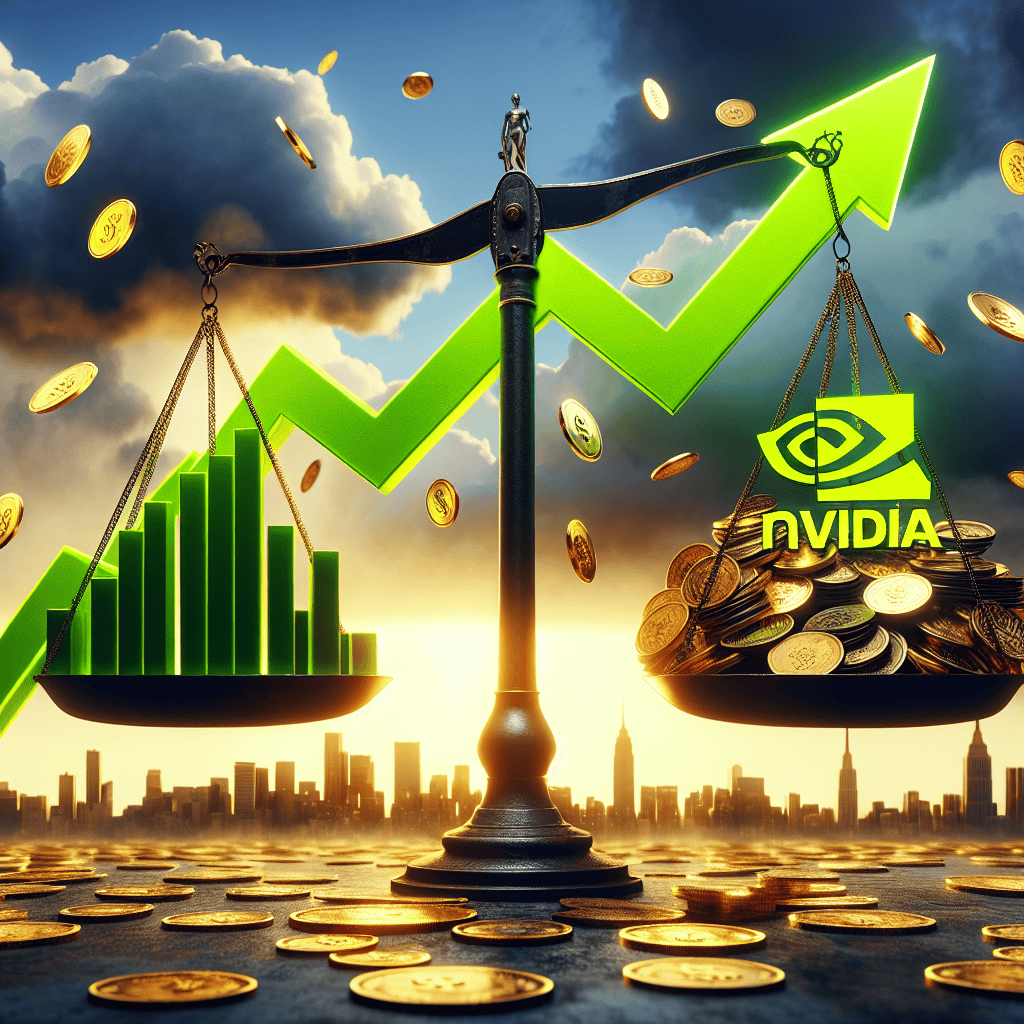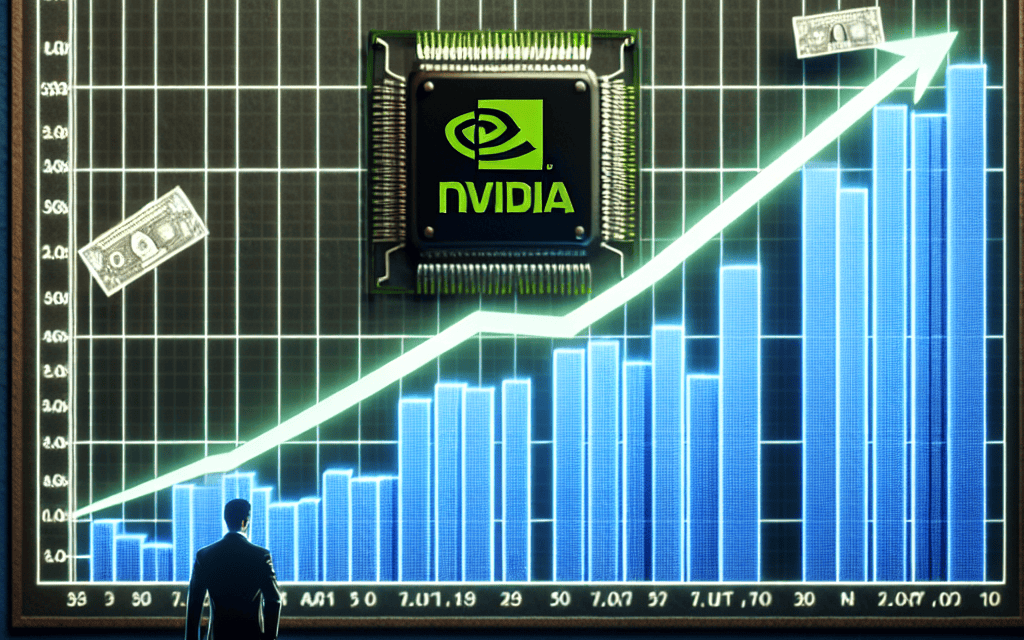“Riding the Wave: Nvidia’s Surge Signals a Shift in Tech Titans”
Introduction
Nvidia’s stock has experienced a notable rise amid speculation about its potential inclusion in the Dow Jones Industrial Average, possibly replacing Intel. This development is significant as it underscores Nvidia’s growing influence and dominance in the semiconductor industry, driven by its advancements in graphics processing units (GPUs) and artificial intelligence (AI) technologies. The potential shift in the Dow’s composition reflects broader market trends favoring companies at the forefront of technological innovation. Nvidia’s inclusion would not only enhance its visibility and prestige but also attract a wider range of investors, potentially boosting its stock value further. This move highlights the evolving landscape of the tech industry, where traditional giants like Intel face increasing competition from agile, forward-thinking companies like Nvidia.
Nvidia’s Market Performance: A Closer Look at Recent Gains
Nvidia’s stock has recently experienced a notable surge, capturing the attention of investors and market analysts alike. This upward trajectory is largely attributed to speculation surrounding its potential inclusion in the Dow Jones Industrial Average, possibly replacing Intel. Understanding the implications of such a move requires a closer examination of Nvidia’s market performance and the broader context of its industry standing.
To begin with, Nvidia has consistently demonstrated robust financial health, driven by its leadership in the graphics processing unit (GPU) market. The company’s innovative approach to technology, particularly in areas such as artificial intelligence, gaming, and data centers, has positioned it as a formidable player in the tech industry. This strong market presence has translated into impressive revenue growth, which has, in turn, bolstered investor confidence. As a result, Nvidia’s stock has become increasingly attractive to those seeking to capitalize on the burgeoning tech sector.
In contrast, Intel, once a dominant force in the semiconductor industry, has faced challenges in recent years. The company has struggled with production delays and increased competition, particularly from companies like AMD and Nvidia itself. These issues have led to a stagnation in Intel’s stock performance, prompting discussions about its potential removal from the Dow. The Dow Jones Industrial Average, a prestigious index comprising 30 significant publicly traded companies, aims to reflect the broader economic landscape. Therefore, the inclusion of a company like Nvidia, which is at the forefront of technological innovation, could better represent the current dynamics of the tech industry.
Moreover, Nvidia’s potential inclusion in the Dow would not only signify a shift in market perception but also have tangible effects on its stock. Being part of the Dow often leads to increased visibility and credibility among investors, which can drive further investment. Additionally, many index funds and institutional investors that track the Dow would be compelled to purchase Nvidia shares, potentially boosting its stock price even further. This increased demand could create a positive feedback loop, enhancing Nvidia’s market capitalization and solidifying its position as a leading tech company.
Furthermore, the potential replacement of Intel with Nvidia in the Dow highlights a broader trend within the tech industry. As technology continues to evolve at a rapid pace, companies that can adapt and innovate are more likely to thrive. Nvidia’s focus on cutting-edge technologies, such as AI and machine learning, aligns with the growing demand for advanced computing solutions. This strategic positioning not only sets Nvidia apart from its competitors but also underscores the importance of innovation in maintaining market relevance.
In conclusion, Nvidia’s recent stock rise amid speculation of its potential inclusion in the Dow over Intel is a reflection of its strong market performance and strategic positioning within the tech industry. The implications of such a move extend beyond mere symbolism, offering tangible benefits in terms of increased visibility and investment. As the tech landscape continues to evolve, companies like Nvidia that prioritize innovation and adaptability are poised to lead the charge, shaping the future of the industry. This potential shift in the Dow composition serves as a testament to the dynamic nature of the market and the ever-changing forces that drive it.
The Impact of Potential Dow Inclusion on Nvidia’s Stock
Nvidia’s stock has recently experienced a notable surge, driven by speculation surrounding its potential inclusion in the Dow Jones Industrial Average, possibly replacing Intel. This development is significant for several reasons, as it not only reflects Nvidia’s growing influence in the technology sector but also underscores the shifting dynamics within the semiconductor industry. Understanding the implications of such a move requires a closer examination of the factors contributing to Nvidia’s rise and the broader impact on the market.
To begin with, Nvidia’s ascent can be attributed to its robust financial performance and strategic positioning in key growth areas such as artificial intelligence, gaming, and data centers. The company’s innovative graphics processing units (GPUs) have become essential components in these rapidly expanding sectors, driving substantial revenue growth. As a result, Nvidia has consistently outperformed market expectations, solidifying its reputation as a leader in cutting-edge technology. This financial strength and market leadership make Nvidia an attractive candidate for inclusion in the Dow, a prestigious index that represents 30 of the largest and most influential companies in the United States.
In contrast, Intel, once a dominant force in the semiconductor industry, has faced challenges in recent years. The company has struggled with production delays and increased competition from rivals like AMD and Nvidia. These issues have impacted Intel’s market share and financial performance, leading to questions about its long-term growth prospects. Consequently, some analysts argue that replacing Intel with Nvidia in the Dow would better reflect the current state of the technology sector and the evolving landscape of the semiconductor industry.
The potential inclusion of Nvidia in the Dow carries significant implications for both the company and the broader market. For Nvidia, being part of the Dow would enhance its visibility and prestige, potentially attracting a new wave of investors. Inclusion in the index often leads to increased demand for a company’s stock, as many investment funds and institutional investors track the Dow and adjust their portfolios accordingly. This heightened demand could further boost Nvidia’s stock price, reinforcing its position as a market leader.
Moreover, the potential reshuffling of the Dow components highlights the ongoing transformation within the technology sector. The rise of Nvidia at the expense of Intel symbolizes a shift towards companies that are at the forefront of innovation and are well-positioned to capitalize on emerging trends. This transition reflects broader changes in the global economy, where technological advancements are driving growth and reshaping industries.
Furthermore, the potential impact on Intel should not be underestimated. Being removed from the Dow could be perceived as a setback for the company, potentially affecting investor confidence and its stock price. However, it could also serve as a catalyst for Intel to refocus its efforts and address the challenges it faces, ultimately leading to a more competitive and dynamic semiconductor industry.
In conclusion, the speculation surrounding Nvidia’s potential inclusion in the Dow Jones Industrial Average over Intel is a reflection of the shifting dynamics within the technology sector. Nvidia’s strong financial performance and strategic positioning make it a compelling candidate for the index, while Intel’s recent struggles highlight the challenges facing traditional semiconductor companies. The potential reshuffling of the Dow components underscores the importance of innovation and adaptability in today’s rapidly evolving market, with significant implications for both Nvidia and the broader industry.
Comparing Nvidia and Intel: Key Differences in Market Strategy
Nvidia and Intel, two giants in the semiconductor industry, have long been at the forefront of technological innovation, each carving out a distinct niche in the market. As Nvidia’s stock continues to rise, buoyed by speculation of its potential inclusion in the Dow Jones Industrial Average over Intel, it is crucial to understand the key differences in their market strategies that have led to this pivotal moment.
Nvidia’s approach has been characterized by its focus on graphics processing units (GPUs), which have become indispensable in a variety of applications beyond gaming, such as artificial intelligence (AI), data centers, and autonomous vehicles. This strategic diversification has allowed Nvidia to tap into rapidly growing markets, positioning itself as a leader in AI and machine learning. The company’s GPUs are renowned for their parallel processing capabilities, making them ideal for handling complex computations required in AI and deep learning tasks. Consequently, Nvidia has seen substantial growth in its data center business, which has become a significant revenue driver.
In contrast, Intel has traditionally dominated the central processing unit (CPU) market, supplying chips for personal computers and servers. However, the company has faced challenges in recent years, including delays in advancing its manufacturing technology and increased competition from rivals like AMD. While Intel has made efforts to diversify its portfolio, such as investing in AI and autonomous driving technologies, it has struggled to match Nvidia’s pace of innovation and market penetration in these areas. This has led to a perception that Intel is lagging behind in adapting to the evolving demands of the tech industry.
Moreover, Nvidia’s strategic acquisitions have played a crucial role in its market strategy. The company’s purchase of Mellanox Technologies, a leader in high-performance computing and networking, has strengthened its position in the data center market. Additionally, Nvidia’s attempt to acquire ARM Holdings, although ultimately unsuccessful, signaled its ambition to expand its influence across the semiconductor landscape. These moves underscore Nvidia’s proactive approach to growth and its commitment to staying ahead of industry trends.
Intel, on the other hand, has been more conservative in its acquisition strategy, focusing on organic growth and incremental improvements to its existing product lines. While this approach has its merits, it has not provided the same level of dynamism and market excitement that Nvidia has generated. As a result, investors have shown greater confidence in Nvidia’s ability to capitalize on emerging opportunities, contributing to the rise in its stock price.
The potential inclusion of Nvidia in the Dow Jones Industrial Average over Intel would be a significant milestone, reflecting a shift in market dynamics and investor sentiment. It would symbolize Nvidia’s ascendancy as a key player in the tech industry, while highlighting the challenges Intel faces in maintaining its historical dominance. This development matters not only for the companies involved but also for the broader market, as it underscores the importance of innovation and adaptability in an ever-evolving technological landscape.
In conclusion, the contrasting market strategies of Nvidia and Intel have led to divergent paths in their business trajectories. Nvidia’s focus on GPUs and strategic acquisitions has positioned it as a leader in high-growth areas, while Intel’s traditional emphasis on CPUs and cautious approach to diversification have posed challenges. As Nvidia’s stock rises amid speculation of its potential Dow inclusion, it serves as a testament to the company’s successful navigation of the rapidly changing tech industry.
Why Nvidia’s Growth Outpaces Intel in the Current Market

Nvidia’s stock has been on a remarkable upward trajectory, capturing the attention of investors and analysts alike. This surge in value is not merely a reflection of market trends but is deeply rooted in the company’s strategic positioning and innovative prowess. As speculation mounts about Nvidia’s potential inclusion in the Dow Jones Industrial Average, possibly at the expense of Intel, it is crucial to understand the factors driving Nvidia’s growth and why it outpaces Intel in the current market landscape.
To begin with, Nvidia’s focus on cutting-edge technology has positioned it as a leader in the semiconductor industry. The company’s advancements in graphics processing units (GPUs) have not only revolutionized gaming but have also found applications in artificial intelligence (AI), data centers, and autonomous vehicles. This diversification into high-growth sectors has provided Nvidia with multiple revenue streams, insulating it from the volatility that often plagues companies reliant on a single market segment. In contrast, Intel has faced challenges in diversifying its portfolio, with its core business still heavily dependent on the PC market, which has seen stagnation in recent years.
Moreover, Nvidia’s strategic acquisitions have bolstered its market position. The acquisition of Mellanox Technologies, for instance, has strengthened Nvidia’s data center capabilities, allowing it to compete more effectively in a sector that is experiencing exponential growth. This move has not only expanded Nvidia’s product offerings but has also enhanced its ability to deliver comprehensive solutions to its clients. On the other hand, Intel’s acquisition strategy has been met with mixed results, with some ventures failing to deliver the anticipated synergies and growth.
In addition to strategic acquisitions, Nvidia’s commitment to research and development (R&D) has been a significant driver of its success. The company consistently allocates a substantial portion of its revenue to R&D, ensuring that it remains at the forefront of technological innovation. This commitment has resulted in a steady stream of new products and technologies that meet the evolving needs of its customers. Intel, while also investing in R&D, has faced delays in product launches and technological advancements, which have hindered its ability to compete effectively with Nvidia.
Furthermore, Nvidia’s ability to forge strategic partnerships has played a crucial role in its growth. Collaborations with major tech companies and cloud service providers have expanded Nvidia’s reach and influence in the industry. These partnerships have not only increased Nvidia’s market share but have also solidified its reputation as a trusted and reliable partner. In contrast, Intel has struggled to maintain its dominance in the face of increasing competition and shifting industry dynamics.
As Nvidia continues to outpace Intel in terms of growth and innovation, the potential inclusion of Nvidia in the Dow Jones Industrial Average underscores the shifting landscape of the semiconductor industry. Such a move would not only reflect Nvidia’s rising prominence but also signal a broader recognition of the importance of AI and data-centric technologies in the modern economy. For investors, this potential inclusion represents an opportunity to align with a company that is well-positioned to capitalize on future technological advancements.
In conclusion, Nvidia’s growth trajectory is a testament to its strategic vision, innovative capabilities, and ability to adapt to changing market conditions. As the company continues to expand its influence and redefine the boundaries of technology, it is poised to remain a dominant force in the semiconductor industry, outpacing competitors like Intel and capturing the imagination of investors worldwide.
The Role of AI and Gaming in Nvidia’s Stock Surge
Nvidia’s stock has been on a remarkable upward trajectory, driven by its strategic positioning in the artificial intelligence (AI) and gaming sectors. This surge has sparked discussions about the potential inclusion of Nvidia in the Dow Jones Industrial Average, possibly replacing Intel. Understanding the factors behind Nvidia’s stock rise and its implications for the market requires a closer look at the company’s role in AI and gaming.
To begin with, Nvidia has established itself as a leader in the AI industry, a sector that has seen exponential growth in recent years. The company’s graphics processing units (GPUs) are not only pivotal for gaming but also serve as the backbone for AI applications. These GPUs are designed to handle complex computations at high speeds, making them ideal for training AI models. As AI continues to permeate various industries, from healthcare to autonomous vehicles, Nvidia’s technology becomes increasingly indispensable. This growing demand for AI capabilities has significantly contributed to the company’s financial performance, thereby boosting its stock value.
Moreover, Nvidia’s influence in the gaming industry cannot be overstated. The company has consistently pushed the boundaries of gaming technology, delivering cutting-edge graphics and immersive experiences. With the rise of eSports and the increasing popularity of gaming as a mainstream form of entertainment, Nvidia’s products have become essential for both casual and professional gamers. The launch of new gaming consoles and the ongoing development of virtual reality (VR) and augmented reality (AR) technologies further amplify the demand for Nvidia’s GPUs. Consequently, the gaming sector remains a robust pillar supporting Nvidia’s stock surge.
In addition to its technological advancements, Nvidia’s strategic acquisitions have played a crucial role in its stock performance. The acquisition of Mellanox Technologies, for instance, expanded Nvidia’s capabilities in data center solutions, a critical area for AI and cloud computing. Such strategic moves have not only diversified Nvidia’s portfolio but also strengthened its position in key markets, enhancing investor confidence and driving stock prices higher.
The potential inclusion of Nvidia in the Dow Jones Industrial Average, replacing Intel, is a testament to the company’s growing influence and market capitalization. The Dow is a price-weighted index, meaning that companies with higher stock prices have a more significant impact on the index’s movements. Nvidia’s rising stock price makes it an attractive candidate for inclusion, reflecting its importance in the tech sector. This potential shift underscores the changing landscape of the technology industry, where companies at the forefront of AI and gaming are gaining prominence over traditional semiconductor firms.
Furthermore, Nvidia’s potential inclusion in the Dow could have broader implications for the stock market. It would signal a shift in investor focus towards companies that are driving innovation in emerging technologies. This could lead to increased investment in AI and gaming sectors, further fueling their growth. Additionally, being part of the Dow would enhance Nvidia’s visibility among investors, potentially attracting more institutional investment and contributing to its stock’s upward momentum.
In conclusion, Nvidia’s stock rise is intricately linked to its leadership in AI and gaming, sectors that are reshaping the technological landscape. The company’s strategic initiatives and market positioning have not only bolstered its financial performance but also positioned it as a potential candidate for the Dow Jones Industrial Average. As Nvidia continues to innovate and expand its influence, its stock trajectory will likely remain a focal point for investors and market analysts alike.
Investor Sentiment: How Nvidia’s Potential Dow Inclusion Influences Decisions
Investor sentiment plays a crucial role in shaping market dynamics, and the potential inclusion of Nvidia in the Dow Jones Industrial Average over Intel has sparked considerable interest among investors. This development is not just a matter of prestige; it carries significant implications for both companies and the broader market. Understanding why Nvidia’s potential inclusion matters requires a closer look at the factors driving this shift and its potential impact on investor decisions.
To begin with, the Dow Jones Industrial Average is one of the most recognized stock market indices globally, representing 30 prominent companies across various industries. Inclusion in the Dow is often seen as a hallmark of corporate success and stability. For Nvidia, a company that has seen exponential growth in recent years, being considered for inclusion is a testament to its rising influence in the technology sector. This potential shift reflects Nvidia’s robust financial performance, driven by its leadership in graphics processing units (GPUs) and its strategic expansion into artificial intelligence (AI) and data centers.
In contrast, Intel, a long-standing member of the Dow, has faced challenges in recent years, including increased competition and delays in product development. While Intel remains a significant player in the semiconductor industry, its struggles have raised questions about its ability to maintain its position in the rapidly evolving tech landscape. Consequently, the possibility of Nvidia replacing Intel in the Dow is seen by many investors as a reflection of the changing guard in the semiconductor industry.
The potential inclusion of Nvidia in the Dow has several implications for investor sentiment. Firstly, it could lead to increased visibility and credibility for Nvidia, attracting a broader range of institutional investors who track the Dow. This heightened interest could drive up demand for Nvidia’s stock, potentially boosting its price. Moreover, being part of the Dow often results in increased media coverage and analyst attention, further enhancing investor confidence in the company’s prospects.
Additionally, the potential shift underscores the growing importance of AI and data-centric technologies in the modern economy. Nvidia’s success in these areas positions it as a key player in the future of technology, appealing to investors seeking exposure to cutting-edge innovations. This focus on AI and data centers aligns with broader market trends, as companies across industries increasingly rely on these technologies to drive growth and efficiency.
Furthermore, the potential replacement of Intel with Nvidia in the Dow highlights the dynamic nature of the stock market and the need for investors to adapt to changing circumstances. It serves as a reminder that even established companies can face challenges, while emerging players can quickly rise to prominence. This realization may prompt investors to reassess their portfolios, considering the potential for growth in sectors driven by technological advancements.
In conclusion, the potential inclusion of Nvidia in the Dow Jones Industrial Average over Intel is more than just a symbolic change; it reflects broader shifts in the technology sector and has significant implications for investor sentiment. As Nvidia continues to capitalize on its strengths in AI and data centers, its potential inclusion in the Dow could enhance its visibility and attract a wider range of investors. This development underscores the importance of staying attuned to market trends and adapting investment strategies accordingly, as the landscape of the technology industry continues to evolve.
Future Prospects: What Nvidia’s Rise Means for the Tech Industry
Nvidia’s recent stock surge has captured the attention of investors and analysts alike, particularly as speculation mounts regarding its potential inclusion in the Dow Jones Industrial Average, possibly at the expense of Intel. This development is not just a matter of market dynamics but also a reflection of broader shifts within the technology sector. As Nvidia’s market capitalization continues to grow, driven by its leadership in graphics processing units (GPUs) and artificial intelligence (AI) technologies, its potential inclusion in the Dow could signify a pivotal moment for the tech industry.
To understand why Nvidia’s rise is significant, it is essential to consider the company’s strategic positioning within the tech landscape. Nvidia has established itself as a leader in GPU technology, which is crucial for a wide range of applications, from gaming to data centers and AI. The company’s GPUs are renowned for their performance and efficiency, making them indispensable in the development of AI models and high-performance computing tasks. This technological edge has allowed Nvidia to capitalize on the growing demand for AI and machine learning solutions, positioning it as a key player in the future of computing.
Moreover, Nvidia’s potential inclusion in the Dow would mark a shift in the index’s composition, reflecting the evolving priorities of the tech industry. Traditionally, the Dow has been composed of companies that represent the industrial backbone of the economy. However, as technology becomes increasingly integral to all sectors, the inclusion of a company like Nvidia would underscore the importance of innovation and digital transformation. This shift would not only validate Nvidia’s role in the tech ecosystem but also highlight the growing influence of AI and data-driven technologies in shaping the future.
In contrast, Intel, once a dominant force in the semiconductor industry, has faced challenges in recent years. The company has struggled with delays in its manufacturing processes and increased competition from rivals like AMD and Nvidia. While Intel remains a significant player, its potential removal from the Dow could signal a broader industry trend where traditional semiconductor companies must adapt to the rapid pace of technological change or risk being overshadowed by more agile competitors.
The implications of Nvidia’s rise extend beyond the stock market and into the broader tech industry. As Nvidia continues to innovate and expand its product offerings, it sets a benchmark for other companies striving to lead in AI and high-performance computing. This competitive pressure could drive further advancements in technology, fostering an environment of innovation that benefits consumers and businesses alike.
Furthermore, Nvidia’s success story serves as a case study for the importance of strategic foresight and adaptability in the tech industry. By anticipating market trends and investing in cutting-edge technologies, Nvidia has positioned itself as a leader in a rapidly evolving landscape. This approach not only enhances its market position but also provides valuable lessons for other companies seeking to navigate the complexities of the digital age.
In conclusion, Nvidia’s potential inclusion in the Dow Jones Industrial Average is more than just a financial milestone; it is a testament to the transformative power of technology and innovation. As the tech industry continues to evolve, companies like Nvidia that embrace change and drive progress will play a crucial role in shaping the future. This development underscores the importance of staying ahead of technological trends and highlights the dynamic nature of the tech sector, where adaptability and innovation are key to success.
Q&A
1. **What is the main reason for Nvidia’s stock rise?**
Nvidia’s stock rose due to speculation about its potential inclusion in the Dow Jones Industrial Average, replacing Intel.
2. **Why is Nvidia’s potential inclusion in the Dow significant?**
Inclusion in the Dow could increase Nvidia’s visibility and attract more investment from index funds and institutional investors.
3. **How does the Dow Jones Industrial Average select companies?**
The Dow selects companies based on their industry leadership, financial health, and representation of the U.S. economy, among other factors.
4. **What impact could Nvidia’s inclusion have on Intel?**
If Nvidia replaces Intel in the Dow, it could negatively impact Intel’s stock due to reduced visibility and investment interest.
5. **How does Nvidia’s market capitalization compare to Intel’s?**
Nvidia’s market capitalization is significantly higher than Intel’s, reflecting its strong growth and market position.
6. **What role does Nvidia play in the tech industry?**
Nvidia is a leader in graphics processing units (GPUs) and has a strong presence in AI, gaming, and data centers.
7. **What are the potential benefits for Nvidia if included in the Dow?**
Benefits include increased prestige, broader investor base, and potential stock price appreciation due to higher demand.
Conclusion
Nvidia’s stock rise amid potential inclusion in the Dow Jones Industrial Average over Intel is significant for several reasons. Firstly, it reflects Nvidia’s growing influence and leadership in the semiconductor industry, driven by its advancements in AI, gaming, and data center technologies. Inclusion in the Dow would enhance Nvidia’s visibility and credibility among investors, potentially attracting more institutional investment. It also signifies a shift in the tech landscape, highlighting the increasing importance of AI and graphics processing technologies over traditional computing. This potential change underscores the evolving dynamics of the tech sector and the market’s recognition of Nvidia’s strategic positioning and growth prospects.





